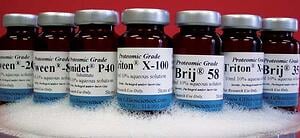 While detergents play a vital role in separating proteins from the hydrophobic portions of the cell membrane during extraction and sample preparation, they need to be removed after successfully serving their purpose to prevent them from interfering with downstream applications (e.g., IEF, ELISA, protease digestion of proteins).
While detergents play a vital role in separating proteins from the hydrophobic portions of the cell membrane during extraction and sample preparation, they need to be removed after successfully serving their purpose to prevent them from interfering with downstream applications (e.g., IEF, ELISA, protease digestion of proteins).
So, how do you make sure you remove all, or at least the majority, of the detergent you used in extracting, purifying, or solubilizing your target protein? Here are some of the best detergent removal methods that can help you accomplish this goal.
Removing Detergents in Protein Samples
Gel Filtration
Detergents can be easily removed via gel filtration or size exclusion chromatography. In this method, detergent monomers, along with urea, buffer salts, and other small molecules are separated from larger molecules (e.g., proteins and other macromolecules) using a desalting spin column with an appropriate size-exclusion medium (i.e., resin) or centrifugal filter with the right molecular weight cut off (MWCO) membrane.
In other words, gel filtration separates molecules by size, whereby the larger molecules pass through the gel matrix and into the void volume while the smaller detergent monomers remain trapped in the gel. To ensure the reproducibility of results, the pH, ionic strength, and temperature should be kept constant.
Dialysis
Dialysis uses the same principle as gel filtration, in the sense that it uses size-exclusion as the basis for removing unwanted molecules like detergents. However, these two methods also differ, since (1) dialysis is more time-consuming than gel filtration and (2) dialysis retains the species with higher MW while gel filtration retains the species with lower MW.
Through this method, the protein molecules are separated from the detergent monomers through passive diffusion. The detergent solution is diluted below the critical micelle concentration (CMC) to disperse the micelles into monomers (which are significantly smaller than micelles). In cases where dilution is not practical, the micelles can be dispersed using other techniques (e.g., addition of bile salts).
Ion-Exchange Chromatography
If you’re working with non-ionic and zwitterionic detergents in cleaning up or purifying your protein samples, you’ll have a better chance of successfully removing the detergent monomers through ion-exchange chromatography.
With this method, the protein molecules are adsorbed on the surface of the resin, while the detergent micelles are allowed to pass through. The protein molecules are then washed with a detergent-free buffer. Complete elution can be facilitated by altering the pH or the ionic strength of the solution.
Recommended Detergent Removal Methods
Not all detergents can be removed by gel filtration or dialysis. Generally, detergents with low CMC (e.g., Triton X-100, Triton X-114, NP-40) are more difficult to remove from a solution, since they bind strongly with protein molecules. GBio’s DetergentOUTTM GBS10 resin exhibits high binding capacity for detergents and is ideal for eliminating free, unbound detergent (either anionic, nonionic, or zwitterionic) such as Triton X-100, CHAPS, or SDS from aqueous solutions with negligible sample loss.
Similarly, the OrgoSol DetergentOUT kit can also be used for all types of detergents and works well with hydrophobic proteins. This kit uses the principle of protein precipitation and is ideal for purifying and concentrating protein solutions for subsequent downstream applications like electrophoresis, isoelectric focusing, 2D gels, protein assays, and other such applications. The OrgoSol DetergentOUT kit is highly flexible, does not depend on detergent concentration, and can be used for processing small and large sample volumes.
Non-denaturing, non-ionic polysorbate (Tween) detergents cannot be removed through dialysis, but can be removed by using DetergentOUT Tween, a spin-column format detergent-removal resin made specifically for this purpose. DetergentOUT Tween can be used to remove polysorbate detergents more effectively without significant protein loss.






